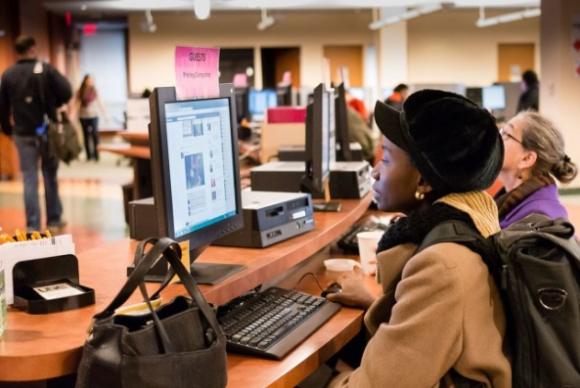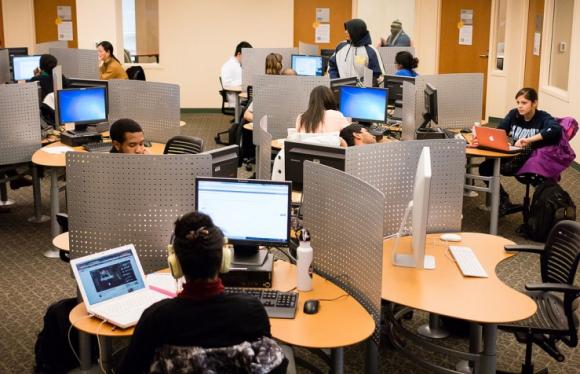View from the 5th – March 2014

March 2014 – Planning for our Users

At the Health Sciences Library we pride ourselves on taking time to learn about our users’ needs and fully understanding the environments in which they work. Our informed assessment of the most important resources and services to provide on a day-to-day basis ultimately impacts the research, instruction and clinical practice of the faculty, staff and students that we serve. We seek areas where we can make our users’ work more efficient and effective, striving always to fulfill our mission of connecting people everywhere with knowledge to improve health.
This issue of View from the Fifth features one such effort to “Understand our Users,” and how diving into user and staff feedback advanced our annual planning process as a library. Read about the Understanding our Users sessions that the entire library staff took part in to exchange knowledge about the groups of HSL users they serve. Then learn how we’re capitalizing on new technology and opportunities to increase user engagement, based on the final session focused on Outreach to the Community. Finally, find out how we planned with our users in mind for the upcoming fiscal year.
The more we engage our users in dialogue, the better we can help them reach their goals – and hopefully surpass them. We’re grateful for Friends like you whose generous gifts make it possible for us to fully support future members of the healthcare field, educators and researchers as we move collectively toward our mission to deliver excellence at UNC.
Sincerely,
Jim Curtis
Interim Director, Health Sciences Library
Lessons Learned from “Understanding our Users”
Outreach and Services to the Community
Planning Retreat and Moving Forward
Lessons Learned from “Understanding our Users”
“If the staff across the library better understand our own value, they will have those kinds of conversations outside the library and with the people they serve. Their excitement and motivation helps us serve our users and leverage our strengths.” – Margaret Moore, Director of Planning for the Health Sciences Library
This year, the Health Sciences Library (HSL) took a new, inclusive and cohesive planning approach to better evaluate the changing needs of the health affairs groups it serves. This in-depth program to understand all of our users was designed to better help the library persist in its mission to provide the best resources and services possible to a diverse user community in light of budget limitations.

Over the course of three months, the entire HSL staff was invited to participate in a series of five “Understanding our Users” sessions, each based on a theme from the University Library Strategic Plan. Representatives from each area spoke about their work, the types of users they reach and their users’ unique challenges.
The sessions ran from November 2013 through January 2014 and covered research and education, use of the HSL facilities, ways that the library is being used in clinical settings and in patient education, results from a survey of UNC faculty, and outreach to the community and the Area Health Education Centers (AHEC). Moore worked with HSL administration and department heads to develop this year’s planning activities, which she credits as critical to the overwhelming success of the sessions.
“We feel it’s absolutely essential to know what is changing for our users and know what is important to our users to provide them with the resources, services and facilities to do their work,” said Moore. “We developed the planning process differently this time by engaging all of our staff at the Understanding our Users sessions, which were grouped by areas related to our strategic plan.”
Following the presentations and group discussion, Moore identified several major themes and emerging opportunities for the HSL. For example, the need to continuously study trends in how the library is used so that the staff can adjust current practices to better serve patrons became a major theme. In addition, planning for advanced physical and virtual spaces dedicated to the research process surfaced an opportunity for the HSL. Because the Understanding our Users sessions were based on the strategic plan, each theme and opportunity lent itself to discussion of how the entire staff can play a part in implementing the plan in the coming years.
At the conclusion of the five meetings, a survey of the participating staff found that the sessions helped members from each library department better understand their colleagues’ work, and find opportunities for increased collaboration and understanding of the library’s many functions.

One staff member said “the more I know about our users, the better I can serve them,” and another added that they “heard several things that lead me to opportunities to join others in projects, or that connected work I was doing to work that others were doing.” HSL librarians, especially liaison librarians, often become connection points for the networks of students, faculty and researchers in the health affairs schools that they serve. The HSL librarians continuously add value to the experience of its users by fostering cross-disciplinary collaboration.
Staff reported a greater understanding of “who our patrons are and how we’re helping them.” More than 80 percent of survey participants said that the information presented by their colleagues will change the way they approach their work, their unit’s work or the library’s work as a whole.
“As a department head and assistant director for the library, I was able to see both cross-cutting and unique challenges our patron groups are facing,” said Fran Allegri, assistant director and head of user services. “Ways that the library can help meet those challenges began to emerge during the discussions.”
As a catalyst in the work of faculty, students and staff in the schools of health at UNC, engaging in dialogue with the user populations the HSL serves is critical to help users be more efficient, and fulfill their needs for services, resources and health information.
Outreach and Services to the Community
“Contributing to a well-informed and productive Carolina citizenry through outreach and partnerships,” is just one goal of the University Libraries strategic plan, jointly created by the HSL. The final Understanding our Users session on Jan. 28, 2014, focused specifically on outreach and services to the community and highlighted current methods HSL librarians and staff reach consumers and healthcare providers in North Carolina and beyond, and the needs of the audiences they reach regularly.

According to Moore, the survey data and comments from the Understanding our Users sessions found that this session had the most reported impact on staff members, as it “opened up people’s minds as to what happens beyond our library,” she said. With this being the final session in the series, time was also allotted to discuss themes from the other three sessions.
The presentations focused on the AHEC Digital Library, outreach to Allied Health clinicians, NC Health Info and NC Live, the YOUR HEALTH Radio Show, the Institute on Aging and global health.
Outreach using technology and opportunities for the HSL to provide more services, instruction and learning using new technologies were key themes that came out of this session.
What does future outreach for the HSL look like?
- On the Web: Emerging trends such as peer-to-peer health information seeking and access to library resources and services using mobile technology sparked new ideas on how the HSL could improve the mobile users’ experience on each platform the library provides.
- Clinical Environments: The transforming landscape of healthcare and imminent move to electronic health records fostered dialogue on how the library might be able to have an impact in patient education and navigation.
- Global Education: Mellanye Lackey, director of global engagement and public health liaison librarian, shared her work in the area of global health and the need to develop cultural sensitivities to positively influence interactions with library users internationally. Lackey and others involved in the group discussion stressed the need for instruction to be independent of location, learning style, and language and better understand best practices for instructional design in our own efforts to meet the teaching and learning themes in the strategic plan.
“The next step would be to hear directly from our users – but it’s challenging to do this,” commented one staff member in the survey conducted by Moore. The series served as a proactive approach to gather holistic feedback from the staff members that directly work with our users. It made user feedback, examples and discussion fresh in the minds of HSL administrators during the annual strategic planning process.
Planning Retreat and Moving Forward
The Understanding our Users sessions ended two weeks before the annual Administrative Planning Retreat, where department heads and HSL’s administration decide upon the library’s priorities and actionable goals for the next fiscal year. However, this year’s retreat was planned differently than years prior. A facilitator led the administrative group through a series of activities and conversations to identify the “muscular core,” or the most vital elements, of what we do as a library, and set candidate priorities for the next fiscal year.
“A big value of the Understanding our Users reports and discussions was accumulating numerous staff interactions with patrons together at once,” said Allegri. “The collective experiences definitely give me a bigger picture of how we can help our patrons even better than we do now. Joining this information with the more systematic data collection we do, such as the recent faculty and student surveys, make each more telling.”
A brainstorming session to generate ideas for action to advance the priorities for the 2014-2015 year followed the retreat and nearly a third of the staff participated in person or provided comments. The brainstorm provided an outlet for staff to suggest actions and strategies for the priorities, as well as provide guidance and professional experience on the challenges and realities for pursuing each priority.
“In every case and priority we considered, I can think of examples of how the Understanding our Users sessions shaped our thinking at the Administrative Planning Retreat,” Interim Director of the Health Sciences Library Jim Curtis said. “The ease with which we came to priorities and narrowed our focus might be a result of the Understanding our Users programs.”
Moore said that she hopes that the Understanding our Users and brainstorming sessions provided a way for staff to see that their contributions make a difference and are part of a greater vision, as well as the value of connecting with our users to provide a better overall experience.
“I’m hoping that the kinds of action plans that are based on these sessions will be more real to the staff and that we’ll be able to move toward these priorities faster,” said Moore.






